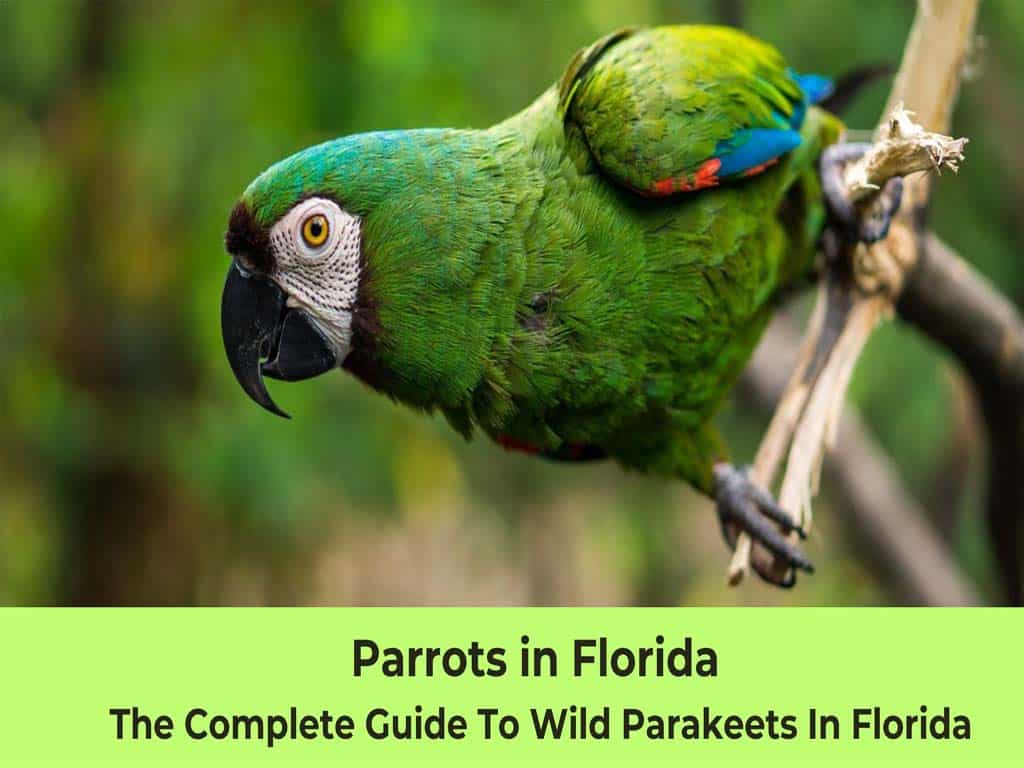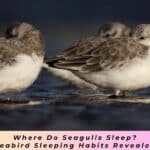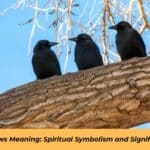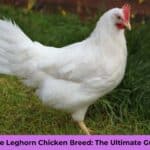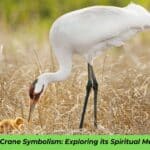Florida’s landscape, dotted with swaying palm trees and abundant fruiting trees, has become an unexpected haven for a vibrant array of feathered interlopers. These parrots in Florida, once fascinating pets, have found freedom in the Sunshine State’s balmy climes. Let’s embark on a journey through the treetops and urban jungles to explore the fascinating realm of wild parrots (parakeets) in Florida.
The Feathered Invasion: Florida’s Unexpected Avian Residents
When you think of Florida’s wildlife, alligators and flamingos might come to mind. But there’s a new flock in town, and they’re making quite a racket. Parrots in Florida parrots, particularly the various species of parakeets, have become an integral part of the state’s ecosystem, for better or worse.
These colorful birds didn’t arrive by natural migration. Instead, their story is one of escape and adaptation. Most of these invasive parrots in Florida trace their origins back to the pet trade. Whether through intentional releases or accidental escapes, these birds found themselves free in a landscape not unlike their native habitats.
“The parakeets of Florida represent a unique case study in urban wildlife adaptation,” says Dr. Avian Researcher, a leading ornithologist studying invasive species. “They’ve turned our cities into their personal playgrounds.”
A Brief History of Florida’s Feathered Phonies
- 1960s-1970s: Initial reports of escaped pet parrots
- 1980s: Established breeding populations observed
- 1990s: Rapid expansion across urban areas
- 2000s-present: Management efforts and increased study
The Parakeet Parade: Who’s Who in Florida’s Skies
Florida’s skies are now home to a diverse array of parakeet species. Let’s meet the main players in this avian drama:
Blue-crowned Parakeets- Parrots In Florida

The Blue-crowned Parrots is a striking bird with a vivid blue crown and forehead. These medium-sized parakeets have adapted well to Florida’s urban environments.
Check this out Why Don’t I Hear Mourning Doves Anymore? Reasons
Key Features:
- Length: 37-38 cm
- Distinctive blue crown
- Green body with blue-tinted wings
- Loud, screeching calls
Habitat Preference: They favor parks, gardens, and areas with tall trees for nesting. Blue-crowned Parrots are often spotted in groups, foraging for seeds, fruits, and nuts in Florida’s lush vegetation.
Mitred Parakeets- Parrots in Florida
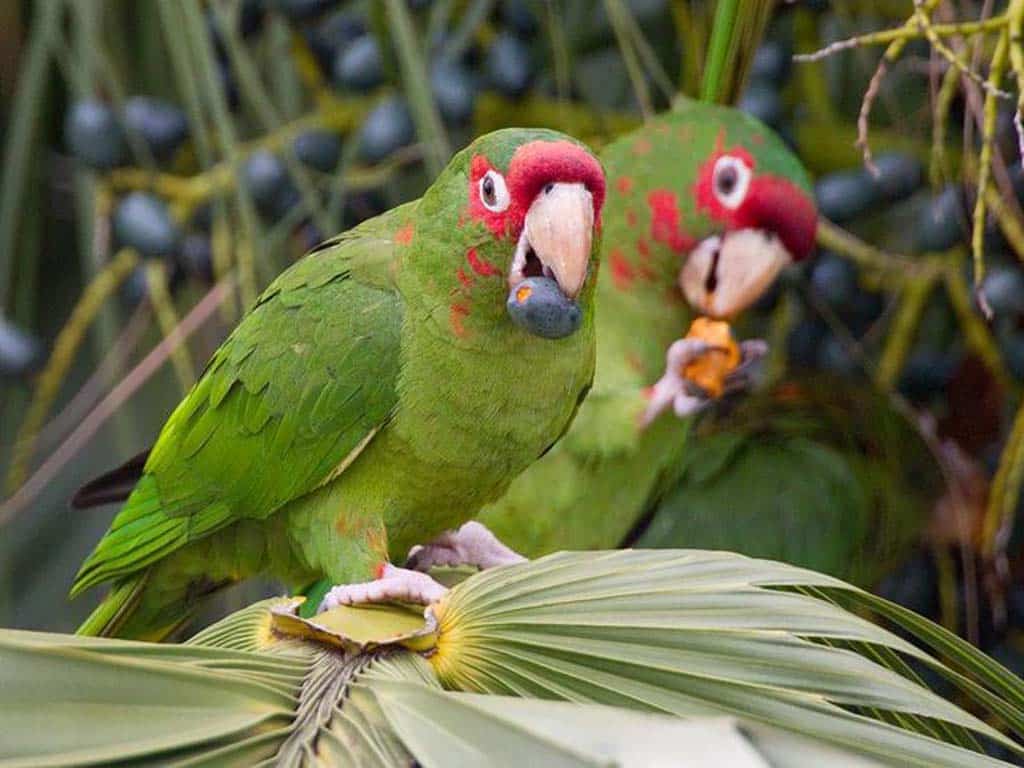
The Mitred Parrots is known for its bright red forehead and crown. These birds have shown remarkable adaptability to Florida’s climate.
Key Features:
- Length: 33-38 cm
- Red forehead and crown
- Green body with red shoulder patches
- Noisy, especially in flight
Adaptation to Florida: They’ve thrived in urban areas, often seen in large, noisy flocks. Mitred Parrots have been particularly successful in South Florida, where they’ve found ample nesting sites in palm trees and other tall vegetation.
Check this out Why Do Hawks Screech? The Surprising Truth
Monk parakeets- Parrots In Florida
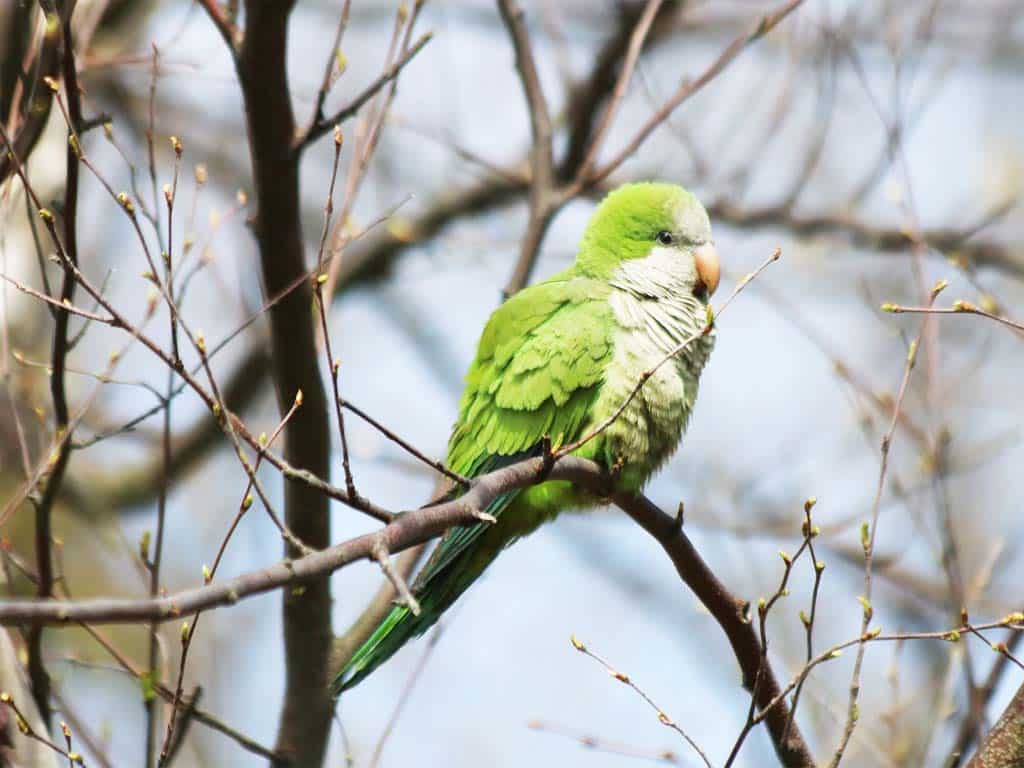
Perhaps the most successful of Florida’s parrots invaders, the Monk Parakeet has made headlines for its unique nesting habits.
Key Features:
- Length: 29 cm
- Bright green plumage with gray breast and forehead
- Only parakeet to build stick nests
Impact on Infrastructure: Monk Parrots often build their large, communal nests on power poles, causing occasional outages and fire hazards. These nests can weigh up to 200 pounds and house multiple pairs of birds, making them a significant concern for utility companies.
Nanday parakeets- Parrots In Florida

The Nanday Parrots also known as the Black-hooded Parrots, is easily recognizable by its distinctive black head.
Key Features:
- Length: 32-37 cm
- Black head and beak
- Green body with blue wing feathers
- Very vocal, with a variety of loud calls
Ecological Effects: These parakeets have been observed feeding on a wide variety of native and non-native plants, potentially impacting local ecosystems. Their diet includes seeds, fruits, flowers, and even some insects.
Check this out Finches in Ohio: 9 Ohio Finches (With Photos)
Red-masked parakeets- Parrots In Florida
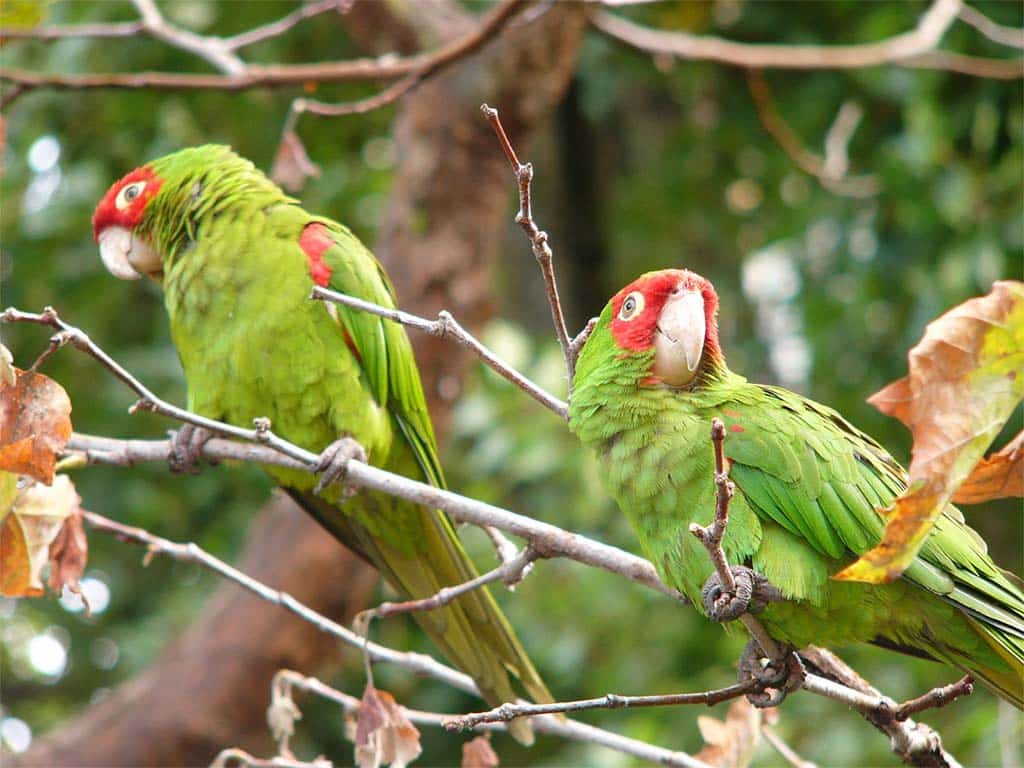
The Red-masked Parrots brings a splash of crimson to Florida’s green landscapes.
Key Features:
- Length: 33-35 cm
- Bright red mask covering forehead and around eyes
- Green body with red shoulder patches
- Known for their intelligence and mimicry abilities
Distribution: While less common than some other species, they’ve established populations in several Florida counties, particularly in the Miami-Dade area.
Yellow-chevroned parakeets- Parrots In Florida

The Yellow-chevroned Parrots is one of the smaller invaders but no less impactful.
Key Features:
- Length: 22-25 cm
- Primarily green with yellow wing patches
- Short, squared tail
- Softer, more melodious calls compared to larger parakeets
Urban Adaptation: These small parakeets are often seen nesting in palm trees and feeding in urban gardens. They’ve shown a particular fondness for fascinating fruits and flowers found in Florida’s landscaped areas.
Check this out Birds With Funny Names – The Complete List of Funny Bird Names
From Pets to Pests: The Great Escape
The story of parrots in Florida is a cautionary tale of unintended consequences. The pet trade played a pivotal role in introducing these species to the state.
Factors Contributing to Parakeet Establishment:
- Subtropical climate similar to native habitats
- Abundance of suitable nesting sites
- Lack of natural predators
- Availability of food sources (both natural and human-provided)
- High reproductive rates
“The success of these parrots in Florida demonstrates the adaptability of these species and the potential consequences of introducing non-native wildlife,” notes Dr. Eco Expert, a professor of invasive species ecology.
Florida’s climate, with its warm temperatures and high humidity, closely mimics the tropical and subtropical regions from which these parakeets originate. This climatic similarity has allowed the birds to thrive year-round, without the need for migration or significant behavioral adaptations.
parrots in florida- Native or Not? Florida’s Parrot Predicament
While Florida now hosts a variety of parakeet species, it’s worth noting that the state once had its own native parrot.
The Lost Legacy of the Carolina Parakeet
The Carolina Parakeet was the only parrot species native to the eastern United States. Tragically, it went extinct in the early 20th century due to habitat loss and hunting.
Carolina Parakeet vs. Current Invasive Species:
| Characteristic | Carolina Parakeet | Invasive Parakeets |
| Native Range | Eastern U.S. | Various (S. America, Asia) |
| Diet | Seeds, fruits, buds | Diverse, adaptable |
| Nesting Habits | Tree cavities | Varies by species |
| Conservation Status | Extinct | Not threatened |
| Impact on Ecosystem | Co-evolved with local flora | Potential disruptors |
The presence of invasive parakeets raises complex questions about ecosystem balance and conservation priorities. While these new arrivals may partially fill the ecological niche left by the Carolina Parakeet, they also introduce new challenges to Florida’s ecosystems.
Check this out Woodpeckers In Michigan – 8 Sensational Michigan Woodpeckers
Living the Parrot Life: Adaptation in the Subtropics
Florida’s climate has proven to be a paradise for these parakeet species. Their success is due to several factors:
- Climate Compatibility: Florida’s subtropical weather mimics their native habitats, allowing for year-round breeding and foraging.
- Dietary Flexibility: Parakeets adapt their diets to available food sources, including:
- Native fruits and seeds
- Ornamental plants in urban areas
- Bird feeders (unintentionally provided by humans)
- Nesting Innovations: Species like the Monk Parakeet have adapted to urban structures for nesting, while others have found suitable homes in Florida’s diverse tree species.
- Predator Avoidance: Many natural predators are unfamiliar with these new arrivals, giving parakeets an initial advantage. However, some local predators, such as hawks and owls, are learning to prey on these colorful newcomers.
Case Study: Monk Parakeet Nesting Behavior
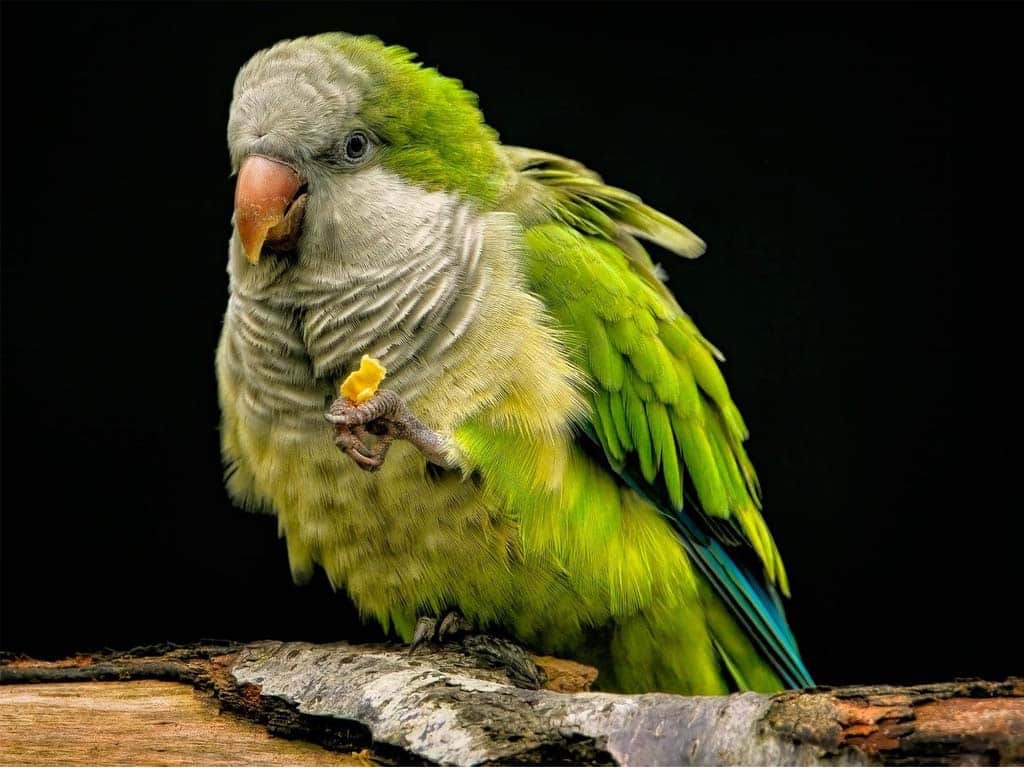
Monk Parrots, unlike other parakeet species, build large, communal stick nests. In Florida, they’ve adapted this behavior to urban environments:
- Location: Often on utility poles, cell towers, and stadium lights
- Size: Nests can reach up to 6 feet in length and 4 feet in width
- Structure: Multiple chambers housing several breeding pairs
- Maintenance: Continuously added to and repaired year-round
This unique nesting behavior has led to conflicts with utility companies but has also fascinated researchers studying urban wildlife adaptation.
Parakeet Palaver: Community Impact and Human Interactions
The presence of parrots in Florida has sparked both delight and concern among residents.
Positive Impacts:
- Increased bird-watching opportunities
- Added color and vibrancy to urban landscapes
- Potential boost to local tourism
Challenges:
- Noise pollution from large, vocal flocks
- Damage to crops and ornamental plants
- Nests on utility structures causing power outages
Case Study: Miami’s Parakeet Problem
In 2019, Miami-Dade County faced a series of power outages caused by Monk Parakeet nests on utility poles. The local power company implemented a nest removal program, which sparked debate among residents and conservationists about the best way to manage the birds.
Key Points of the Miami Case:
- Over 800 nests removed from power infrastructure
- Implementation of nest deterrent devices on poles
- Public education campaign about the impacts of feeding wild parakeets
- Collaboration with wildlife experts to develop humane management strategies
This case highlights the complex challenges of managing invasive species in urban environments, balancing human needs with wildlife conservation.
Conservation Conundrum: Managing Invasive Parakeets
Balancing the presence of these charismatic birds with ecological concerns presents a complex challenge for wildlife managers.
Current Management Strategies:
- Nest removal from critical infrastructure
- Public education about not feeding wild parakeets
- Monitoring of populations and their impacts
- Research into non-lethal control methods
Ethical Considerations:
- Animal welfare concerns in population control
- Balancing native species protection with parakeet management
- Public attachment to these colorful urban residents
“Managing invasive parakeets requires a nuanced approach that considers both ecological impacts and public sentiment,” explains Dr. Wildlife Manager, a consultant for Florida’s Fish and Wildlife Conservation Commission.
Innovative Management Techniques
Researchers and wildlife managers are exploring new methods to control parakeet populations without resorting to lethal measures:
- Contraceptive Bait: Development of species-specific contraceptives that can be distributed through food sources.
- Acoustic Deterrents: Use of targeted sound devices to discourage nesting in sensitive areas.
- Habitat Modification: Altering urban landscapes to be less attractive to parakeets while benefiting native species.
- Citizen Science Initiatives: Engaging the public in monitoring and reporting parakeet activities to inform management decisions.
Citizen Science: Get Involved in Parakeet Research
Floridians can play a crucial role in understanding and managing wild parakeet populations:
- Report Sightings: Use apps like eBird to log parakeet observations, including species, numbers, and behaviors.
- Participate in Surveys: Join local Audubon Society chapters for bird counts and specific parakeet monitoring projects.
- Educate Others: Share information about the impacts of releasing pet birds and the importance of responsible pet ownership.
- Responsible Observation: Follow ethical bird-watching guidelines to minimize disturbance to both parakeets and native wildlife.
Spotlight: The Florida Parakeet Project
The Florida Parakeet Project, a collaborative effort between universities and wildlife agencies, invites citizen scientists to contribute to parakeet research:
- Annual Parakeet Count: A statewide event to estimate population sizes and distributions
- Nesting Survey: Mapping and monitoring of parakeet nesting sites
- Feeding Behavior Study: Documenting the types of food sources utilized by different parakeet species
- Urban Adaptation Research: Investigating how parakeets are adapting to city life in Florida
Participation in such projects not only aids scientific research but also helps foster a sense of stewardship among Florida’s residents.
The Future of Florida’s Feathered Phonies
As Florida’s landscape continues to change, so too will the story of its wild parakeets.
Projected Trends:
- Continued adaptation to urban environments
- Potential range expansion with climate change
- Evolving management strategies as we learn more about their impacts
Long-term Ecological Considerations:
- Competition with native bird species for resources
- Alterations to seed dispersal patterns
- Potential for naturalization and integration into local ecosystems
Climate Change and Parakeet Populations
Climate change is expected to have significant impacts on Florida’s ecosystems, which could, in turn, affect parakeet populations:
- Range Expansion: Warmer temperatures might allow parakeets to expand their range northward.
- Altered Food Availability: Changes in plant flowering and fruiting times could affect food sources.
- Extreme Weather Events: Increased frequency of hurricanes could impact nesting success and population dynamics.
Researchers are closely monitoring these factors to predict future trends in parakeet populations and their ecological impacts.
parrots in florida- Embracing Florida’s Colorful Conundrum
The presence of wild parrots in Florida represents a complex interplay of human activity, ecological adaptation, and conservation challenges. While these vibrant birds add a splash of color to Florida’s skies, they also serve as a reminder of our responsibility in shaping local ecosystems.
As we continue to study and manage these invasive parrots in Florida, we’re learning valuable lessons about urban ecology, species adaptation, and the far-reaching consequences of our actions on the natural world.
Whether you view them as pests or welcome additions, one thing is certain: Florida’s wild parakeets are here to stay, adding their squawks and flashes of color to the rich tapestry of the Sunshine State’s wildlife.
Key Takeaways:
- Florida hosts several species of wild parakeets, each with unique characteristics and impacts.
- These birds, originally pets, have successfully adapted to Florida’s urban and suburban environments.
- While adding color and interest to Florida’s landscapes, parakeets also pose challenges to infrastructure and native ecosystems.
- Management of these invasive species requires a balanced approach, considering both ecological and social factors.
- Citizen involvement in research and monitoring is crucial for understanding and managing parakeet populations.
As Florida continues to grapple with its colorful invaders, the story of wild parakeets serves as a vivid reminder of the complexities of wildlife management in an increasingly interconnected world. These feathered foreigners have become an indelible part of Florida’s ecological narrative, challenging us to reconsider our relationship with nature in urban spaces and our role in shaping the ecosystems around us.

